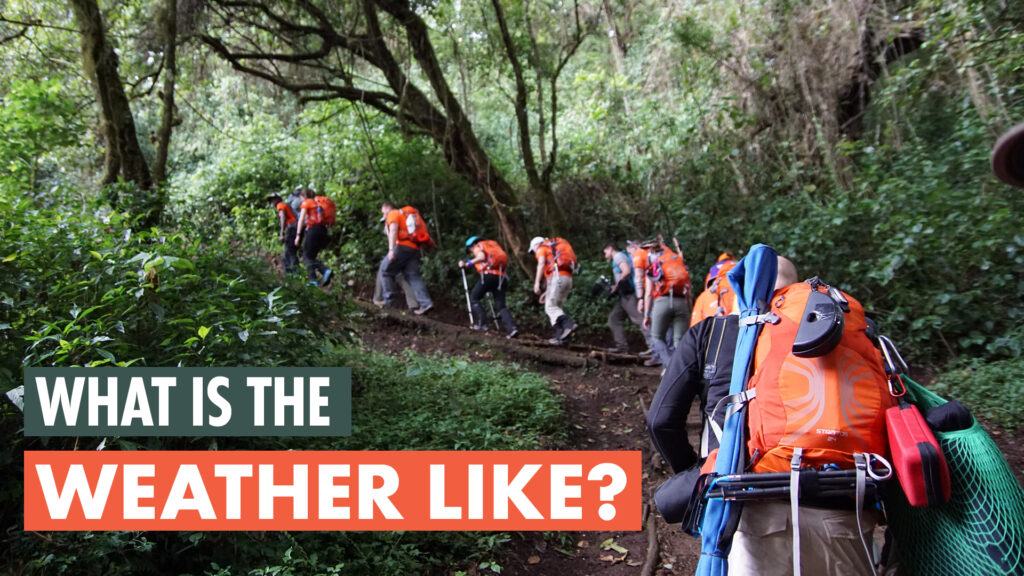
Mount Kilimanjaro is a diverse and dynamic environment in terms of weather due to its various ecological zones. Being close to the equator, it doesn’t undergo significant temperature shifts between seasons. Instead, its temperature variations are primarily influenced by altitude and the time of day. Within a single day, you might go from feeling super warm to quite chilly. Down at the base, it’s usually a pleasant 70 to 80°F. Now, when you reach the top, Uhuru Peak, brace yourself because nighttime temps can dip down from 20 to -4°F! Kilimanjaro has a knack for creating its own weather, which can be a bit unpredictable. So hikers should pack the bags for anything and everything: from sunny days to rain, wind, and even a chance of snow.
Ascending Kilimanjaro is a year-round possibility, but it’s wise to plan your climb during periods with lower precipitation. The prime windows are from early December to early March, and from late June to late October – the dry seasons.
These times offer the most favorable weather conditions, although they also coincide with the peak of activity, known as the high season. Kilimanjaro’s weather patterns can be somewhat unpredictable, and microclimates can develop due to the mountain’s unique topography. Even during the “dry seasons,” there can be occasional rain, especially at higher elevations.
The general distinction between the seasons is the following, marking short dry season, long wet season, short wet season, and long dry season on Kilimanjaro.
Short Dry Season (January to March)
The Short Dry Season on Kilimanjaro, spanning from January to end of March, offers climbers a window of drier and more stable weather conditions. Clear skies and reduced chances of rain create an ideal environment for those seeking a smoother ascent. Keep in mind that January, particularly in the first half, tends to be bustling, with higher airfare costs. If you’re aiming for January, consider planning your trip after the second week for a more relaxed experience.
Long Wet Season (April to May)
Kilimanjaro’s long wet season, from April. Until the end of May, ushers in heavier rainfall, particularly in the lower zones and the lush rainforest. Trails may become muddier and cloud cover can limit visibility, yet some adventurous climbers embrace this season’s challenges. By the end of March, as the trade winds from the Indian Ocean meet the mountain, it marks the onset of the long rainy season.
Short Wet Season (November to December)
The Short Wet Season, occurring in November and December, presents a briefer bout of increased rainfall. While not as intense as the long wet season, the lower zones, especially the rainforest, benefit from the added moisture, creating a vibrant landscape.
Long Dry Season (June to October)
Kilimanjaro’s Long Dry Season, spanning from June to October, brings about drier and more predictable conditions. Clear skies and lower precipitation levels make this period one of the most sought after for climbing. Trails are typically in excellent condition, offering an optimal climbing experience.
And regarding the distinct altitude zones, you should know the following; The Cultivation Zone, the lowest zone where the town of Moshi is located, has a warm tropical climate with higher rainfall. Moving up, you enter the Rainforest Zone, characterized by lush rainforest. It’s cooler than the cultivation zone and receives consistent rainfall throughout the year. Continuing the ascent, you’ll reach the Heath/Moorland Zone, featuring grassy meadows and heath-like vegetation. It’s cooler than the rainforest, with less frequent rainfall. Progressing further, you’ll encounter the Alpine Desert Zone, known for its barren landscape of rocky terrain and sparse vegetation. In this zone, temperatures drop significantly, and there is minimal precipitation. Finally, the Arctic Zone, located above the others, has temperatures that remain consistently below freezing. Precipitation is very low, and the air is thin, with significantly reduced oxygen levels.
Mountains are known to have crazy weather systems that can change dramatically each day. There has been heavy rain during the dry season – and weeks of beautiful weather during the rainy season.
Sometimes the short rains never come. Other times, as soon as you get to Shira Camp or above the rainforest, you have great weather each day. For safety, it’s best to prepare for Kilimanjaro expecting the worst weather.







